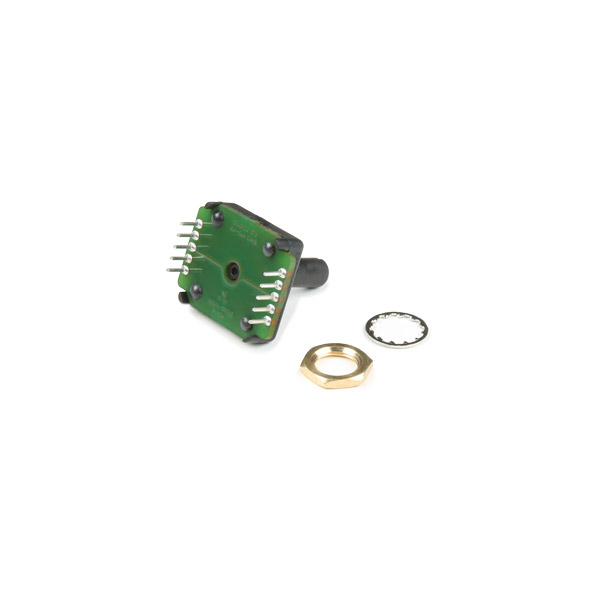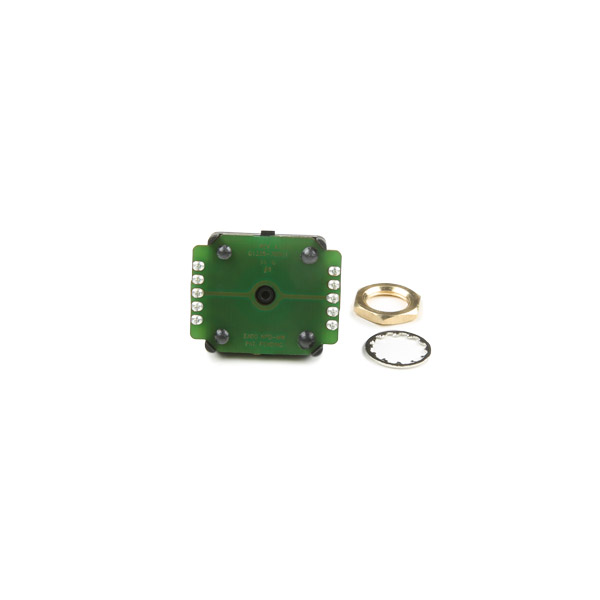Bourns Absolute Encoder (EAW0J-B24-AE0128L)
The Bourns Absolute Encoder is a digital control knob that provides 128 unique results evenly spaced around a full circle. It is designed as a control panel knob but can be adapted for other uses. This can be a good alternative to using a potentiometer and analog pin, as this allows for full-turn and multi-turn operation.
It differs from the more common incremental rotary encoder which has only two or four values in a rotation and is designed to measure full rotations and direction. This measures angles and absolute position is maintained between power cycles.
- Absolute Contacting Encoder (ACE)
- Mounting nut and lockwasher (9mm mounting hole)
- 128 rotary positions
- 360 degree continuous rotation
- Rotational life - 50,000 revolutions (min)
- Max RPM - up to 120
- Absolute digital output will retain its last position between power cycles or in the event of a power failure
- Threaded M9x0.75 in. bushing
- 3/4 in. rotating encoder shaft
- Rear mount terminals
Bourns Absolute Encoder (EAW0J-B24-AE0128L) Product Help and Resources
Core Skill: Soldering
This skill defines how difficult the soldering is on a particular product. It might be a couple simple solder joints, or require special reflow tools.
Skill Level: Noob - Some basic soldering is required, but it is limited to a just a few pins, basic through-hole soldering, and couple (if any) polarized components. A basic soldering iron is all you should need.
See all skill levels
Core Skill: DIY
Whether it's for assembling a kit, hacking an enclosure, or creating your own parts; the DIY skill is all about knowing how to use tools and the techniques associated with them.
Skill Level: Noob - Basic assembly is required. You may need to provide your own basic tools like a screwdriver, hammer or scissors. Power tools or custom parts are not required. Instructions will be included and easy to follow. Sewing may be required, but only with included patterns.
See all skill levels
Core Skill: Electrical Prototyping
If it requires power, you need to know how much, what all the pins do, and how to hook it up. You may need to reference datasheets, schematics, and know the ins and outs of electronics.
Skill Level: Rookie - You may be required to know a bit more about the component, such as orientation, or how to hook it up, in addition to power requirements. You will need to understand polarized components.
See all skill levels
Comments
Looking for answers to technical questions?
We welcome your comments and suggestions below. However, if you are looking for solutions to technical questions please see our Technical Assistance page.
Customer Reviews
5 out of 5
Based on 1 ratings:
1 of 1 found this helpful:
Reasonable delivery time, good quality
It works!




I was wondering if someone could give me some help with the datasheet - specifically page 3 with their EAW <-> decimal conversion system. Is this a random (can't be that) way to convert to decimal? It doesn't seem to be a simple binary to decimal conversion, which suprised me. If I am reading the pins to get the position, do I need to use a lookup table? Thanks for any help, and my apologies if I overlooked something obvious.
was wondering the same thing. Luckily, there are smarter people than me out there..https://www.youtube.com/watch?v=44-XMo730wI
Someone has written a library.
Arduino code at https://github.com/arielnh56/ACE128
Rpi code at https://github.com/arielnh56/ace128-rpi
Whats in it and how it works http://redhunter.com/blog/2017/11/25/inside-the-bourns-ace-128-absolute-encoder/
is there a wiring diagram and any sample sketch?
There is, if you are using this with the I2C I/O expander (i.e. MCP23008)! =)
For more information, check this GitHub repository for example code and the circuit under the extras folder:
The data sheet mentions "ACETAB: 256 byte code conversion table (ROM)", but when I Googled to try to figure out what that was, all I ever found was links back to the data sheet. Also, your description says the device includes pull down resistors, but the data sheet shows "+" on the right side of the RESNET 4609X-101-472 resistor bank, which makes me think it uses pull up resistors. Isn't that what the + represents? I'm new to this and appreciate your patience with my simple questions ;-) This looks like a fantastic new toy and I'm looking forward to playing with it! Thanks in advance for your help!